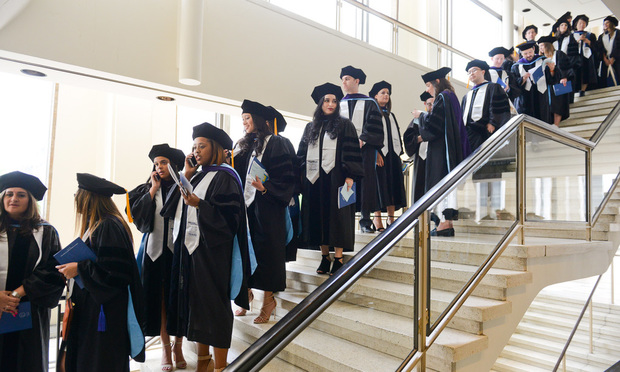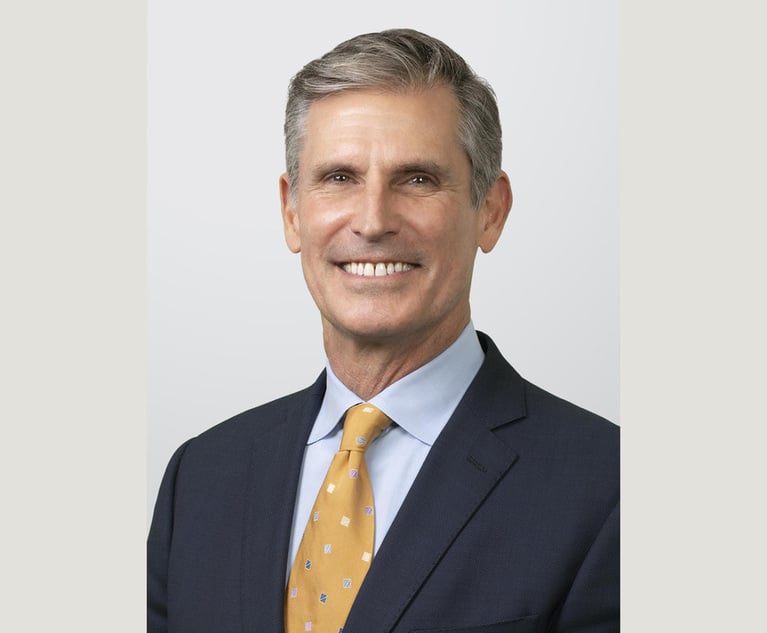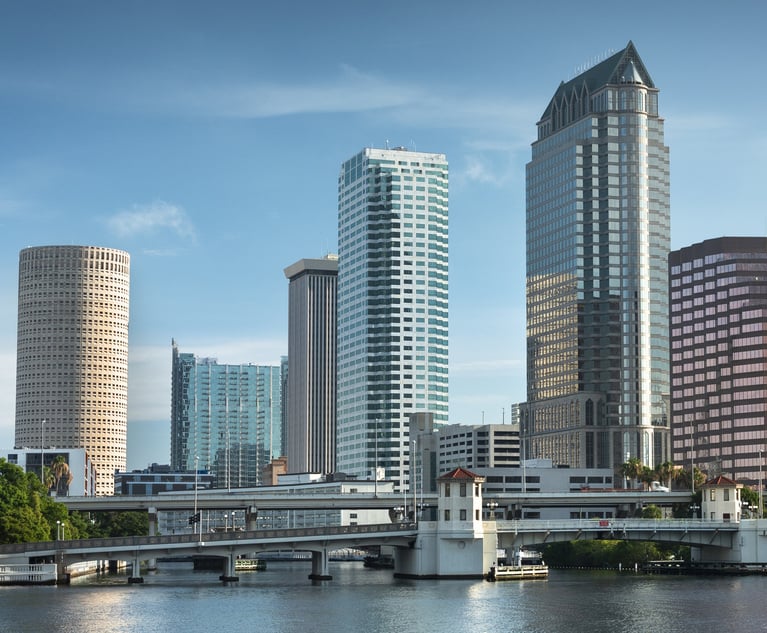5 Florida Law Schools Beat National Average for Employment Rate of 2017 Grads
The University of Florida Fredric G. Levin College of Law, among the 11 law schools in Florida, had the highest employment rate for its 2017 graduates 10 months after graduation.
May 10, 2018 at 04:09 PM
3 minute read

Five of Florida's 11 law schools posted a higher-than-average employment rate for class of 2017 graduates, according to American Bar Association law school employment data.
Nationwide, 75.3 percent of 2017 graduates were employed 10 months after graduation in full-time, long-term jobs that require bar passage or for which a law degree offers an advantage. In Florida, the percentages were 86.4 percent at the University of Florida Fredric G. Levin College of Law, 82.7 percent at the University of Miami School of Law, 80.7 percent at Florida International University College of Law, 80.3 percent at Florida State University College of Law, and 77.2 percent at Stetson University College of Law.
The 10-month post-graduation employment rates for the other schools were below the national average. Those rates were 62.4 percent at Nova Southeastern University Law School, 61.7 percent at Barry University Dwayne O. Andreas School of Law, 58.6 percent at St. Thomas University School of Law, 51.9 percent at Florida A&M University College of Law, 49.4 percent at Ave Maria School of Law, and 46.6 percent at Florida Coastal School of Law.
The overall rate of 75.3 percent is an improvement from the 72.6 percent for graduates of the class of 2016, according to The American Lawyer's Law Grads Hiring Report. The University of Pennsylvania Law School topped the 2017 employment ranking, with 98.8 percent of its 2017 graduates employed after 10 months in full-time, long-term jobs. The ABA data is for 204 law schools.
The American Lawyer's report includes charts that rank the schools on several other employment areas tracked by the ABA, such as unemployment and underemployment after 10 months, the percentage of graduates obtaining federal clerkships, and the percentage of graduates in “elite” jobs at firms of 100 or more lawyers or in federal clerkships.
When considering the Florida schools, Florida Coastal had the highest number of unemployed graduates after 10 months, at 24.8 percent, and Stetson had the lowest with 1.9 percent. Florida Coastal also led the underemployed ranking for Florida schools, with 37.8 percent, and Florida State had the lowest with 8.9 percent underemployed. Underemployed means the graduate is either unemployed, in a temporary or part-time job or in a nonprofessional job.
The report listed the 50 law schools with the most 2017 graduates working at federal clerkships, but no Florida school made that list. Among the Florida schools, the University of Florida had the most 2017 graduates, 20.4 percent, working at “elite” firms, with more than 100 lawyers or in a federal clerkship.
This content has been archived. It is available through our partners, LexisNexis® and Bloomberg Law.
To view this content, please continue to their sites.
Not a Lexis Subscriber?
Subscribe Now
Not a Bloomberg Law Subscriber?
Subscribe Now
NOT FOR REPRINT
© 2025 ALM Global, LLC, All Rights Reserved. Request academic re-use from www.copyright.com. All other uses, submit a request to [email protected]. For more information visit Asset & Logo Licensing.
You Might Like
View All

Holland & Knight Expands Corporate Practice in Texas With Former Greenberg Traurig Partner
3 minute read
Forum Clause Axes $844M Case Against Reinsurer Over Deadly Plane Crash, Judge Rules

Latest Boutique Combination in Florida Continues Am Law 200 Merger Activity
3 minute readTrending Stories
- 1Legal Community Mourns the Loss of Trailblazing Judge Dorothy Chin Brandt
- 2Delaware Supreme Court, Reversing Chancery, Lowers Review Standard for TripAdvisor Move to Nevada
- 3Haynes and Boone Expands in New York With 7-Lawyer Seward & Kissel Fund Finance, Securitization Team
- 4Upstart Insurer That's Wowing Industry Hires AIG Legal Exec to Help Guide Global Expansion
- 5Connecticut Lawyers in Spotlight for Repping FBI Agents
Who Got The Work
J. Brugh Lower of Gibbons has entered an appearance for industrial equipment supplier Devco Corporation in a pending trademark infringement lawsuit. The suit, accusing the defendant of selling knock-off Graco products, was filed Dec. 18 in New Jersey District Court by Rivkin Radler on behalf of Graco Inc. and Graco Minnesota. The case, assigned to U.S. District Judge Zahid N. Quraishi, is 3:24-cv-11294, Graco Inc. et al v. Devco Corporation.
Who Got The Work
Rebecca Maller-Stein and Kent A. Yalowitz of Arnold & Porter Kaye Scholer have entered their appearances for Hanaco Venture Capital and its executives, Lior Prosor and David Frankel, in a pending securities lawsuit. The action, filed on Dec. 24 in New York Southern District Court by Zell, Aron & Co. on behalf of Goldeneye Advisors, accuses the defendants of negligently and fraudulently managing the plaintiff's $1 million investment. The case, assigned to U.S. District Judge Vernon S. Broderick, is 1:24-cv-09918, Goldeneye Advisors, LLC v. Hanaco Venture Capital, Ltd. et al.
Who Got The Work
Attorneys from A&O Shearman has stepped in as defense counsel for Toronto-Dominion Bank and other defendants in a pending securities class action. The suit, filed Dec. 11 in New York Southern District Court by Bleichmar Fonti & Auld, accuses the defendants of concealing the bank's 'pervasive' deficiencies in regards to its compliance with the Bank Secrecy Act and the quality of its anti-money laundering controls. The case, assigned to U.S. District Judge Arun Subramanian, is 1:24-cv-09445, Gonzalez v. The Toronto-Dominion Bank et al.
Who Got The Work
Crown Castle International, a Pennsylvania company providing shared communications infrastructure, has turned to Luke D. Wolf of Gordon Rees Scully Mansukhani to fend off a pending breach-of-contract lawsuit. The court action, filed Nov. 25 in Michigan Eastern District Court by Hooper Hathaway PC on behalf of The Town Residences LLC, accuses Crown Castle of failing to transfer approximately $30,000 in utility payments from T-Mobile in breach of a roof-top lease and assignment agreement. The case, assigned to U.S. District Judge Susan K. Declercq, is 2:24-cv-13131, The Town Residences LLC v. T-Mobile US, Inc. et al.
Who Got The Work
Wilfred P. Coronato and Daniel M. Schwartz of McCarter & English have stepped in as defense counsel to Electrolux Home Products Inc. in a pending product liability lawsuit. The court action, filed Nov. 26 in New York Eastern District Court by Poulos Lopiccolo PC and Nagel Rice LLP on behalf of David Stern, alleges that the defendant's refrigerators’ drawers and shelving repeatedly break and fall apart within months after purchase. The case, assigned to U.S. District Judge Joan M. Azrack, is 2:24-cv-08204, Stern v. Electrolux Home Products, Inc.
Featured Firms
Law Offices of Gary Martin Hays & Associates, P.C.
(470) 294-1674
Law Offices of Mark E. Salomone
(857) 444-6468
Smith & Hassler
(713) 739-1250






